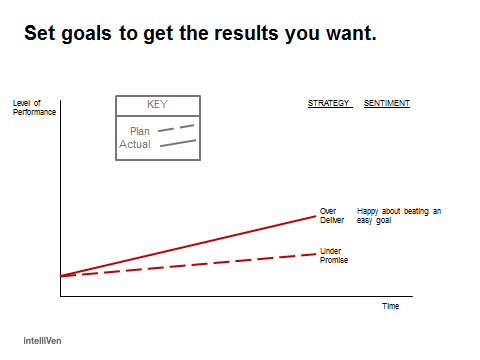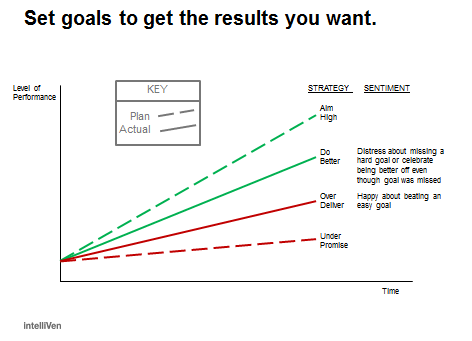The best approach to setting annual performance goals for an organization is to simultaneously pursue two paths, one for the management team and one for the board, investors, and lenders as outlined below.
Stakeholder Plan: The Under-Promise-Over-Deliver Approach

Target Audience: Board, Bankers, and Investors
Objective: Manage downside risk while maintaining credibility.
Strategy: Present conservative, achievable targets to ensure a high probability of meeting or exceeding expectations. This approach builds trust and reassures stakeholders about the management team and their investment, offering a solid foundation for the future.
Outcome: Exceeding conservative estimates provides a reason for celebration and reinforces stakeholder confidenceas suggested by the under-promise and over-deliver lines graphed in Figure-1.
Management Plan: The Aim-High-Do-Better Method

Target Audience: Internal Management and Operating Teams
Objective: Maximize team performance and drive to achieve top-tier results.
Strategy: Set aggressive, yet attainable goals, understanding that they might be achieved 75-80% of the time. This encourages teams to stretch their capabilities and innovate, often leading to superior results compared to a conservative approach even when the goal is not attained.
Adaptation: If mid-period results deviate significantly, either above or below, from plan, be prepared to revise the goals to maintain momentum and direction through the rest of the performance period.
Outcome: Even if actual results fall slightly short of ambitious goals, the organization often ends up in a stronger position than if it had set more cautious targets as suggested by the aim-high and do-better lines added to the graph in Figure-2.
Summary: The Dual-Faceted Approach for Business Growth
- Key Insight: Leaders of growing businesses should adopt a dual strategy in goal setting. Internally, aggressive but achievable goals fuel motivation and high performance, while externally, conservative, and intelligent goal setting satisfies the risk-averse nature of bankers and investors.
- Result: This balanced approach ensures robust operational performance while maintaining the confidence and support of external financial stakeholders.

